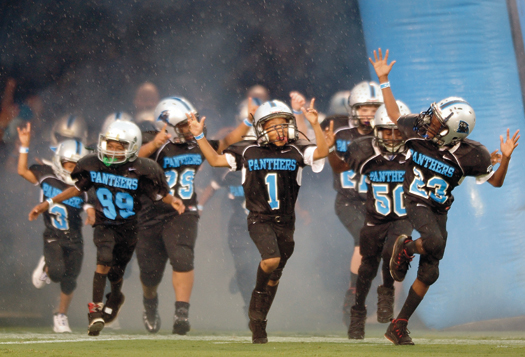
The Ebinport youth football team runs onto the field at Bank of America Stadium in Charlotte, N.C., prior to the preseason game between the Carolina Panthers and New York Giants on Aug. 13, 2011. (Photo by Jeff Siner/Charlotte Observer/MCT)
Chris Prawdzik, president of Chicago’s North Shore Youth Football Club, knows the ins and outs of youth football programming quite well. Youth Today recently asked the seven-year veteran of youth football management about key practices all directors and operators should to ensure a successful — and safe — experience for the nation’s youngest athletes.
Concussion Policies
“Set a policy, make sure everyone is aware of it, and you have everybody on board,” Prawdzik said.
Oftentimes, he explained, young athletes may want to continue playing after potential head injuries, but Prawdzik implores coaches to keep children out of action if they are displaying any concussion symptoms. “They need to sit out, and they need to be examined by a physician,” he said.
Communication with Families
“Quite simply, safety first,” Prawdzik said. “Youth football is being looked at with a magnifier; everybody’s watching, and everybody wants change.”
In youth sports programming, communication between managers and parents is key. “If you can communicate to your families and kids what you’re doing, and then follow through with that, I think you set yourself apart [and] strive for a better program.”
Waivers and Liability Forms
“Liability-wise, we as a program have all our participating families sign waivers,” he said. “And we make sure that, as a program, we are properly insured and that our facilities are properly insured.”
Waivers, he continued, are an absolute necessity for youth sports programs. “Unfortunately, some things can happen,” Prawdzik said. “And you need to be sure you’re protected as a program.”
Players with Preexisting Health Conditions
Prawdzik said that all players in his program are required to fill out medical history forms before stepping on a field. “If there are some red flags that come up, we have to address them,” he said.
However, Prawdzik said that youth football programs do not need to be completely exclusionary. For example, this season, Prawdzik said that his club is fielding its first player who has autism. “We have a wonderful situation with a coach who is certified to work with challenged children,” he stated. “It might be a life-altering opportunity, not only for the family of the child involved, but everybody in the program.”
Overall, program managers and directors must adhere to safety measures and follow through with all policies and protocols, even when lesser standards seem to suffice.
As Prawdzik said, “The game of football can be a great game to play, but when people cut corners — which happens a lot — bad things happen.”































